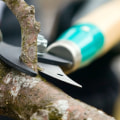Cutting down trees is a complex process that requires careful planning and execution. The five-step felling plan is widely used by professional chainsaw operators around the world and is incorporated into the ANSI Z-133.1 standard for tree care operations. This plan helps ensure successful results consistently. The first step of the Logging Plan is called heights, hazards and inclination.
You must determine the height of the tree, assess the tree and area for hazards, and measure the inclination. There are two high-danger zones and two safer retreat routes within the radius of the tree. The first high-hazard zone occupies a semicircle from the center of the tree that goes outwards in the direction of the fall. The second high danger zone is a quarter-circle area in the opposite direction to the felling direction. You must determine the height of the tree, assess the tree and area for hazards, and measure the inclination. There are two high-danger zones and two safer retreat routes within the radius of the tree. The first high-hazard zone occupies a semicircle from the center of the tree that goes outwards in the direction of the fall. The second high danger zone is a quarter-circle area in the opposite direction to the felling direction.
Remove any mobile clutter, debris or garden debris from the “drop zone” before beginning. The next step is to remove the lower branches of the tree (a process known as “delimbing”) with a pole trimmer, jigsaw, or foot-level chainsaw. To maintain control of your chainsaw, never use it above shoulder height. Always set the chain brake until you are ready to operate it.
Never drop any branches or sections you cut, as any debris that falls could cause injury. Use a fall arrest harness, securing it to you and to the tree according to the operating instructions, before climbing the ladder. If you have more than 3 feet of lateral tilt, you must come up with a new plan. Cut any weeds around the trunk and clear two escape routes on the “no fall” side of the tree. If you decide to remove the tree on your own, especially for smaller projects on your own property, you can use these steps to cut a tree into sections. You will need to determine the height of the tree, identify hazards, measure inclination and evaluate available equipment before you can fully determine the direction of logging.
Unbranching the tree at higher heights will make individual sections more manageable and will help you prevent a branch from hitting backwards. In extreme cases, you can use a rope and a winch, which is the safest and most powerful way to knock down a tree. Lower the chainsaw, lower the ladder and reattach and fix the ladder to the other side of the tree. It is important to remember that cutting down trees is a complex process that requires careful planning and execution. Professional arborists or tree removal services should be consulted for larger projects. We have served Portland metropolitan area and all surrounding communities since 2000, with more than 30 years of experience in residential and commercial tree care.



